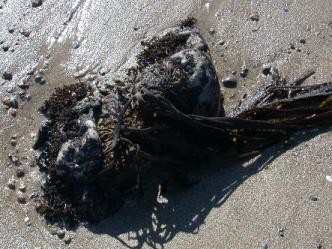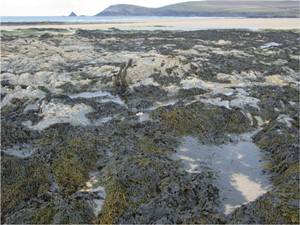
Adaptations of F. vesiculosus
Adapt or perish, now as ever, is
nature's inexorable imperative.
-H.G. Wells
Hold on!
Fucus vesiculosus has a number of morphological
adaptations that are extremely beneficial. First, the organism
has evolved what is called a holdfast. This is root-like
structure that connects the entire organism to the substrate or
ground. The holdfast ensures that the organism doesn't float away
from an area that it has evolved to thrive in, for example,
moving from an area of lower temperatures to higher
temperatures, and also changes in the salinity of the water. The
picture to the right shows a holdfast of another brown algae.
Notice the root-like structures that are all over the substrate.
Thin and flat
Bladderwrack has also evolved to be somewhat of a specialist in
surface area to volume ratio. The alga has extremely flat blades that allow it to soak up as much sunlight as possible
without having to sacrifice many nutrients, which would be the
case if more cells were present in the blade. This flat
morphology also allows local production of sugars, and also
allows for the plant to simply get its water through osmosis.
This is the reason why Bladderwrack hasn't evolved vascular
tissue like the plants have.
The reason for the
brown color?
There is also a special pigment that has evolved in Fucus
vesiculosus that allows for a greater absorption of light,
fucoxanthin. This extra absorption makes photosynthesis a lot more
efficient. You can find out more about photosynthesis and
Bladderwrack's source of nutrients by going to the
nutrition
page.
The famous bladders
As was stated on the home page, F. vesiculosus
is known for the air bladders found in pairs on its blades. These
bladders help keep the brown algae afloat when the tide comes in so
photosynthesis can continue at a more productive rate. The bladders
are filled with mostly O2 that is a product of
photosythesis. The bladders are held together by a network of white
filaments, that as the organism gets older, break, and leave the
bladder incapable of holding any gases. After only a couple years,
F. vesiculosus will only have bladders towards the younger
end of the thallus.
Just trying to
survive
Bladderwrack has quite a few predators since it is a primary
producer. Fortunately enough for bladderwrack, however, is it has
developed a way to prevent this herbivory. Fucus vesiculosus
has developed a certain set of compounds called phlorotannins.
Scientists have found that this resists grazing from herbivores by
looking at the lower levels of damage of a bladderwrack thallus with
higher levels of phlorotannins relative to thalli that have lower
levels of these compounds.
 Sea
Sickness
Sea
Sickness
Fucus vesiculosus inhabits a place where the waves can be
especially harsh. Waves can smash the thalli against rocks and other
algae in the area, which can cause damage to the bladders and the
organism as a whole. To prevent damage from this constant motion
while submerged and battering against other objects, F.
vesiculosus has developed gel-forming polysaccharides that
helps cushion the thallus of the organism. These polysaccharides
also help prevent
desiccation when low tide
comes and the organism is subjected to harsh rays from the sun.
